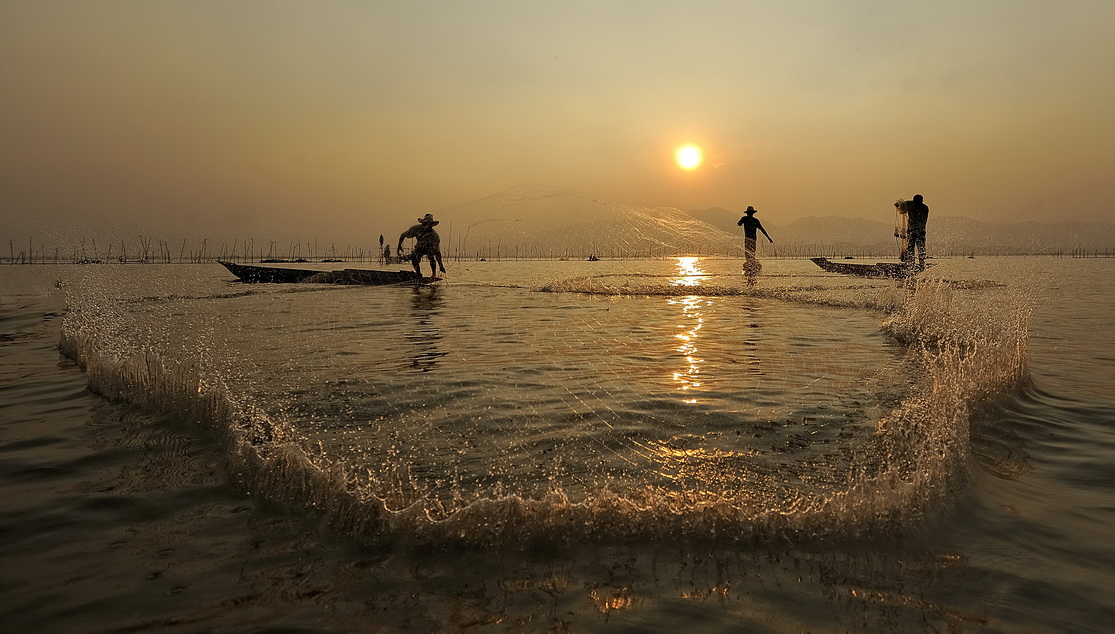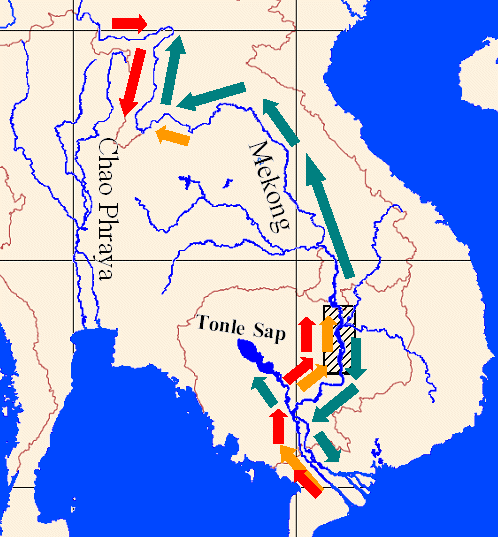|
Phayao Lake
Kwan Phayao ( th, กว๊านพะเยา, , ) is a lake in Phayao Province, northern Thailand. ''Kwan'', a word from the northern Thai language, means 'lake' or 'large swamp'. The shape of the lake is a nearly-half-circle-moon shape. Phayao Lake is the largest freshwater lake in the northern region and the fourth largest in the country, with a depth of 1.5 metres, and covers an area of about 1,980 hectares. There are about 50 species of fish in Phayao Lake. History Phayao Lake began from the collapse of lithosphere in about 70 million years ago. This area was surrounded by low mountains before. There are 18 creeks mixing together here. In 1935, the department of fisheries had set up Phayao inland fisheries station on Ing River and made the dam, which cause a large swamp with a depth of 1.5 metres. “Nong Lang” was one of the most prominent ponds. The land at the northern and southern ends of the area during summer is dry, so it is possible to walk through the area. ... [...More Info...] [...Related Items...] OR: [Wikipedia] [Google] [Baidu] |
Rai (unit)
A ''rai'' ( th, ไร่, ) is a unit of area equal to 1,600 square metres (16 ares, 0.16 hectares, 0.3954 acres), and is used in measuring land area for a cadastre or cadastral map. Its current size is precisely derived from the metre, but is neither part of nor recognized by the modern metric system, the International System (SI). The rai is defined as 1 square ''sen'' or (40 m × 40 m). It can be divided in four ''ngaan'' or 400 square '' wa''. It is commonly used in Thailand. Although recognized by the SI, its use is not encouraged. The word ''rai'' also means plantation. See also * Thai units of measurement * Orders of magnitude (area) This page is a progressive and labelled list of the SI area orders of magnitude, with certain examples appended to some list objects. to square metres 10−8 to 10−1 square metres 100 to 107 square metres 108 to 1014 square metres 101 ... References External links Area metric conversion British and U.S., Japanese, Chines ... [...More Info...] [...Related Items...] OR: [Wikipedia] [Google] [Baidu] |
Anabas Testudineus
The climbing perch (''Anabas testudineus'') is a species of amphibious freshwater fish in the family Anabantidae (the climbing gouramis). A labyrinth fish native to Far Eastern Asia, the fish inhabits freshwater systems from Pakistan, India, Bangladesh and Sri Lanka in the west, to Southern China and Japan in the east, and to Southeast Asia west of the Wallace Line in the south. It is likely that ''Anabas testudineus'' is a species complex, with the binomial name applied to what are actually several different species. With further study, populations of this fish may be divided up into separate species and given new names. The climbing perch is euryhaline and can grow to in total length. Outside its native ranges, it is an invasive species that can live without water for 6–10 hours and move on land by crawling/wriggling the body with its pectoral fins. It is believed that the fish may be invading new territories by slipping aboard fishing boats. The fish has been establi ... [...More Info...] [...Related Items...] OR: [Wikipedia] [Google] [Baidu] |
Nile Tilapia
The Nile tilapia (''Oreochromis niloticus'') is a species of tilapia, a cichlid fish native to the northern half of Africa and the Levante area, including Israel, and Lebanon. Numerous introduced populations exist outside its natural range. It is also commercially known as mango fish, nilotica, or boulti. The first name leads to easy confusion with another tilapia which is traded commercially, the mango tilapia (''Sarotherodon galilaeus''). Description The Nile tilapia reaches up to in length, and can exceed . As typical of tilapia, males reach a larger size and grow faster than females. Wild, natural-type Nile tilapias are brownish or grayish overall, often with indistinct banding on their body, and the tail is vertically striped. When breeding, males become reddish, especially on their fins. Although commonly confused with the blue tilapia (''O. aureus''), that species lacks the striped tail pattern, has a red edge to the dorsal fin (this edge is gray or black in Nile tilap ... [...More Info...] [...Related Items...] OR: [Wikipedia] [Google] [Baidu] |
Common Carp
The Eurasian carp or European carp (''Cyprinus carpio''), widely known as the common carp, is a widespread freshwater fish of eutrophic waters in lakes and large rivers in Europe and Asia.Fishbase''Cyprinus carpio'' Linnaeus, 1758/ref>Arkive The native wild populations are considered vulnerable to extinction by the International Union for Conservation of Nature (IUCN), but the species has also been domesticated and introduced (see aquaculture) into environments worldwide, and is often considered a destructive invasive species, being included in the list of the world's 100 worst invasive species. It gives its name to the carp family, Cyprinidae. Taxonomy The two subspecies are: * ''Cyprinus carpio carpio'', native to much of Europe (notably the Danube and Volga rivers)Jian Feng Zhou, Qing Jiang Wu, Yu Zhen Ye & Jin Gou Tong (2003). Genetic divergence between ''Cyprinus carpio carpio'' and ''Cyprinus carpio haematopterus'' as assessed by mitochondrial DNA analysis, with emphasis ... [...More Info...] [...Related Items...] OR: [Wikipedia] [Google] [Baidu] |
Cyprinidae
Cyprinidae is a family of freshwater fish commonly called the carp or minnow family. It includes the carps, the true minnows, and relatives like the barbs and barbels. Cyprinidae is the largest and most diverse fish family and the largest vertebrate animal family in general with about 3,000 species, of which only 1,270 remain extant, divided into about 370 genera. Cyprinids range from about 12 mm in size to the giant barb (''Catlocarpio siamensis''). By genus and species count, the family makes up more than two-thirds of the ostariophysian order Cypriniformes. The family name is derived from the Greek word ( 'carp'). Biology and ecology Cyprinids are stomachless fish with toothless jaws. Even so, food can be effectively chewed by the gill rakers of the specialized last gill bow. These pharyngeal teeth allow the fish to make chewing motions against a chewing plate formed by a bony process of the skull. The pharyngeal teeth are unique to each species and are used by scient ... [...More Info...] [...Related Items...] OR: [Wikipedia] [Google] [Baidu] |
Iridescent Shark
The iridescent shark, iridescent shark catfish (''Pangasianodon hypophthalmus'') is a species of shark catfish (family Pangasiidae) native to the rivers of Southeast Asia. Despite its name, it is not a shark. It is found in the Mekong basin as well as the Chao Phraya River, and is heavily cultivated for food there. The meat is often marketed under the common name swai (from Thai สวาย). It has also been introduced into other river basins as a food source, and its striking appearance and iridescence have made it popular with fishkeeping hobbyists, among whom it is also known as the Siamese shark catfish or sutchi catfish. The swai's omnivorous diet consists of crustaceans, other fish, and plant matter. Names The fish is named for the glow or iridescence exhibited in juveniles, as well as the shark-like appearance of this and other shark catfish. Description Adults reach up to in length and can weigh up to a maximum of . They have a shiny, iridescent color that gives th ... [...More Info...] [...Related Items...] OR: [Wikipedia] [Google] [Baidu] |
Wat Phrathan Chomthong
A wat ( km, វត្ត, ; lo, ວັດ, ; th, วัด, ; khb, 「ᩅᨯ᩠ᨰ」(waD+Dha); nod, 「ᩅ᩠ᨯ᩶」 (w+Da2)) is a type of Buddhist temple and Hindu temple in Cambodia, Laos, East Shan State, Yunnan, the Southern Province of Sri Lanka and Thailand. The word ''wat'' is a Thai word that was borrowed from Sanskrit ''vāṭa'' (Devanāgarī: वाट), meaning 'enclosure'. The term has varying meanings in each region, sometimes referring to a specific type of government-recognised or large temple, other times referring to any Buddhist or Hindu temple. Overview Strictly speaking, a ''wat'' is a buddhism, Buddhist sacred precinct with vihara (quarters for bhikkhus), a temple, an edifice housing a large image of Buddha and a facility for lessons. A site without a minimum of three resident ''bhikkhu''s cannot correctly be described as a wat although the term is frequently used more loosely, even for ruins of ancient temples. As a transitive or intransitive ... [...More Info...] [...Related Items...] OR: [Wikipedia] [Google] [Baidu] |
Kwan Phayao1
Kwan may refer to: People * Kwan (surname) (關), a Chinese surname * Kwan Cheatham (born 1995), American basketball player for Ironi Nes Ziona of the Israel Basketball Premier League * nickname of Kwandwane Browne (born 1977), Trinidadian field hockey player * nickname of Suchakree Kwan Poomjang (born 1975), Thai former professional snooker player *Kwan, Canadian music producer, songwriter and engineer Other uses * Kwan, Canadian music producer, songwriter and engineer * Kwan (band), a Finnish hip hop/pop group. * Kwan (martial arts), a Korean term for a school or clan of martial artists. * Mandarin (bureaucrat), bureaucrat scholar in the government of Joseon dynasty. * String of cash coins (currency unit), a superunit of the Korean mun. See also *Guan (other) * Kuang (other) *Kwon *Quan *Quon (other) Quon could refer to * Guan, a Chinese family name rendered in Cantonese as ''Kwan'', or also in English as ''Quan'' or ''Quon'' * Quon Kisaragi ... [...More Info...] [...Related Items...] OR: [Wikipedia] [Google] [Baidu] |
Scirpus
''Scirpus'' is a genus of grass-like species in the sedge family Cyperaceae many with the common names club-rush, wood club-rush or bulrush (see also bulrush for other plant genera so-named). They mostly inhabit wetlands and damp locations. Taxonomy The taxonomy of the genus is complex, and under review by botanists. Recent studies by taxonomists of the Cyperaceae have resulted in the creation of several new genera, including the genera ''Schoenoplectus'' and ''Bolboschoenus''; others (including '' Blysmus'', ''Isolepis'', '' Nomochloa'', and ''Scirpoides'') have also been used. At one point this genus held almost 300 species, but many of the species once assigned to it have now been reassigned, and it now holds an estimated 120 species. Description ''Scirpus'' are rhizomatous perennial herbs, with 3-angled stems and flat grass-like leaves. The flowers are in clusters of small spikelets, often brown or greenish brown. Some species (e.g. ''S. lacustris'') can reach a height of 3 m ... [...More Info...] [...Related Items...] OR: [Wikipedia] [Google] [Baidu] |
Eichhornia Crassipes
''Pontederia crassipes'' (formerly ''Eichhornia crassipes''), commonly known as common water hyacinth is an aquatic plant native to South America, naturalized throughout the world, and often invasive species, invasive outside its native range.''Pontederia crassipes'' Kew Royal Botanic Gardens Plants of the World Online. Accessed April 19, 2022.''Eichhornia crassipes'' Kew Royal Botanic Gardens Plants of the World Online. Accessed April 19, 2022. June 15, 2016. ... [...More Info...] [...Related Items...] OR: [Wikipedia] [Google] [Baidu] |
Nelumbo Nucifera
''Nelumbo nucifera'', also known as sacred lotus, Laxmi lotus, Indian lotus, or simply lotus, is one of two extant species of aquatic plant in the family Nelumbonaceae. It is sometimes colloquially called a water lily, though this more often refers to members of the family Nymphaeaceae. Lotus plants are adapted to grow in the flood plains of slow-moving rivers and delta areas. Stands of lotus drop hundreds of thousands of seeds every year to the bottom of the pond. While some sprout immediately, and most are eaten by wildlife, the remaining seeds can remain dormant for an extensive period of time as the pond silts in and dries out. During flood conditions, sediments containing these seeds are broken open, and the dormant seeds rehydrate and begin a new lotus colony. Under favorable circumstances, the seeds of this aquatic perennial may remain viable for many years, with the oldest recorded lotus germination being from seeds 1,300 years old recovered from a dry lakebed in n ... [...More Info...] [...Related Items...] OR: [Wikipedia] [Google] [Baidu] |





.jpg)

